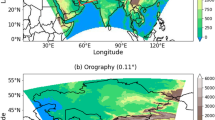Summary
¶In order to better understand land-atmosphere interactions and increase the predictability of climate models, it is important to investigate the role of forest representation in climate modeling. Corresponding to the “big-leaf” model commonly employed in land surface schemes to represent the effects of a forest, a so called “big-tree” model, which uses multi-layer vegetation to represent the vertical canopy heterogeneity, was introduced and incorporated into the National Center for Atmospheric Research (NCAR) regional climate model RegCM2, to make the vegetation model more physically based. Using this augmented RegCM2 and station data for China during 1991 Meiyu season, we performed 10 experiments to investigate the effects of the application of the “big-tree” model on the summer monsoon climate.
With the “big-tree” model incorporated into the regional climate model, some climate characteristics, e.g. the 3-month-mean surface temperature, circulation, and precipitation, are significantly and systematically changed over the model domain, and the change of the characteristics differs depending on the area. Due to the better representation of the shading effect in the “big-tree” model, the temperature of the lower layer atmosphere above the plant canopy is increased, which further influences the 850 hPa temperature. In addition, there are significant decreases in the mean latent heat fluxes (within 20–30 W/m2) in the three areas of the model domain.
The application of the “big-tree” model influences not only the simulated climate of the forested area, but also that of the whole model domain, and its impact is greater on the lower atmosphere than on the upper atmosphere. The simulated rainfall and surface temperature deviate from the originally simulated result and are (or seem to be) closer to the observations, which implies that an appropriate representation of the “big-tree” model may improve the simulation of the summer monsoon climate.
We also find that the simulated climate is sensitive to some “big-tree” parameter values and schemes, such as the shape, height, zero-plane displacement height and mixing-length scheme. The simulated local/grid differences may be very large although the simulated areal-average differences may be much lower. The area-average differences in the monthly-mean surface temperature and heat fluxes can amount to ∼0.5 °C and ∼4 W/m2, respectively, which correspond to maximum local/grid differences of ∼3.0 °C and ∼40 W/m2 respectively. It seems that the simulated climate is most sensitive to the parameter of the zero-plane displacement among the parameters studied.
Similar content being viewed by others
Author information
Authors and Affiliations
Rights and permissions
About this article
Cite this article
Zeng, XM., Zhao, M., Yu, RC. et al. Application of a “Big-Tree” model to regional climate modeling: a sensitivity study. Theor Appl Climatol 76, 203–218 (2003). https://doi.org/10.1007/s00704-002-0014-7
Received:
Revised:
Accepted:
Published:
Issue Date:
DOI: https://doi.org/10.1007/s00704-002-0014-7




